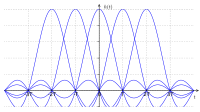
Photo from wikipedia
In this correspondence paper, we study the peak-to-average power ratio (PAPR) problem in orthogonal frequency-division multiplexing systems. In conventional clipping and filtering based PAPR reduction techniques, clipping noise is allowed… Click to show full abstract
In this correspondence paper, we study the peak-to-average power ratio (PAPR) problem in orthogonal frequency-division multiplexing systems. In conventional clipping and filtering based PAPR reduction techniques, clipping noise is allowed to spread over the whole active passband, thus degrading the transmit signal quality similarly at all active subcarriers. However, since modern radio networks support frequency multiplexing of users and services with highly different quality-of-service expectations, clipping noise from PAPR reduction should be distributed unequally over the corresponding physical resource blocks (PRBs). To facilitate this, we present an efficient PAPR reduction technique, where clipping noise can be flexibly controlled and filtered inside the transmitter passband, allowing to control the transmitted signal quality per PRB. Numerical results are provided in 5G new radio mobile network context, demonstrating the flexibility and efficiency of the proposed method.
Journal Title: IEEE Transactions on Vehicular Technology
Year Published: 2019
Link to full text (if available)
Share on Social Media: Sign Up to like & get
recommendations!